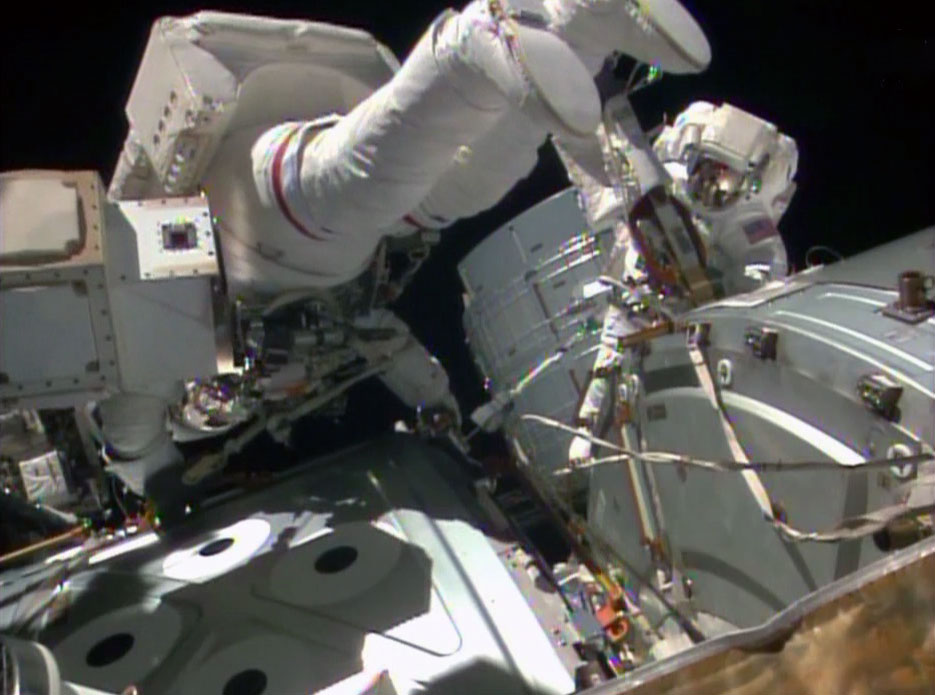
Despite difficulties with stubborn bolts, Expedition 41 spacewalkers Reid Wiseman and Barry “Butch” Wilmore triumphantly concluded U.S. EVA-28 on Wednesday, 15 October, replacing a failed Sequential Shunt Unit (SSU) on the starboard truss of the International Space Station (ISS) and working to replace and relocate cameras and other equipment in anticipation of next year’s arrival of International Docking Adapters (IDAs) and the movement of the Leonardo Permanent Multipurpose Module (PMM) for future Commercial Crew vehicles from 2017. With Wiseman designated “EV1,” having red stripes on the legs of his Extravehicular Mobility Unit (EMU) suit for identification, and Wilmore as “EV2,” clad in a pure-white ensemble, the duo spent six hours and 34 minutes outside the station on the 183rd spacewalk in support of ISS assembly and maintenance.
As described in AmericaSpace’s EVA-28 preview article, this was the first U.S. spacewalk since November 2008 to feature an all-Navy team, with Wiseman currently a commander in the service and Wilmore a captain. Final preparations got underway early Wednesday, when the spacewalkers—assisted by Expedition 41 Commander Max Surayev and German astronaut Alexander Gerst—began 60 minutes of “pre-breathing” on masks, during which time the Quest airlock’s inner “equipment lock” was depressed from its ambient 14.7 psi down to 10.2 psi. Upon completion of this protocol, Wiseman and Wilmore donned and purged their bulky EMUs and the airlock’s atmosphere was repressurized to 14.7 psi.
This allowed them to enter a nominal pre-breathing regime, lasting about 50 minutes, followed by another 50 minutes of In-Suit Light Exercise (ISLE). The latter was first trialed on the STS-134 shuttle mission in May 2011 and involved the men flexing their knees for about four minutes, resting for one minute, then repeating over and over until the 50 minutes was up. The technique served to rapidly remove nitrogen from their bloodstreams and avoid an attack of the “bends.”
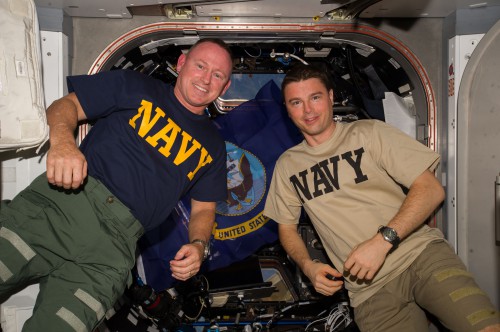
By 7:40 a.m. EDT, the fully-suited pair and their equipment—including the Simplified Aid for EVA Rescue (SAFER) units, affixed to the lower section of their life-sustaining backpacks—were transferred by Gerst from the equipment lock into Quest’s outer “crew lock.” Hatches between the two locks were closed and depressurization got briskly underway, reaching the 5 psi “hold point” for leak checks at about 7:55 a.m. With no issues, the depressurization continued until the crew lock reached a condition of near-vacuum, and EVA-28 officially got underway at 8:16 a.m., when Wiseman and Wilmore transferred their suits’ critical life-support utilities over to internal battery power. Interestingly, this was just one minute later than originally planned in the EVA-28 timeline.
Pushing open the outer hatch, Wiseman departed the airlock first, followed by Wilmore, who brought out the spare Sequential Shunt Unit (SSU) in an Orbital Replacement Unit (ORU) bag. Provided by Space Systems/Loral (SS/L), there are eight SSUs on the space station, responsible for regulating the incoming power from the eight Solar Array Wings (SAW) at an established “set point” of 160 volts, by shunting and unshunting 82 separate array “strings,” to ensure a steady output across the ISS. Weighing 186 pounds (84 kg), each SSU can handle 38.5 kW of electrical power at an efficiency of 98.5 percent.
On 8 May 2014, the station lost its “3A” power channel, when the controlling SSU experienced an internal electrical short. Loads were immediately transferred to the 3B channel, with minimal loss of power, although the Optical Payload for Lasercomm Science (OPALS) and the Alpha Magnetic Spectrometer (AMS)-2 suffered from a temporary suspension of operations. The failure “was associated with a sharp temperature increase … and a high current difference between the two SSU circuits that was six times higher than normal,” according to Spaceflight101 at the time. “These two indications point to a failure internal to the SSU that may not be recoverable by ground commanding.”
With the other seven power channels—1A, 1B, 2A, 2B, 3B, 4A, and 4B—classified as fully functional, the ISS remained in a safe configuration, although the replacement of the failed SSU was important to hedge against the risk of future failures. Originally, this replacement task was planned for August 2014, during Expedition 40, although it was delayed until October and the early stages of Expedition 41 in the wake of problems with Long Life Batteries (LLBs) in the U.S. space suits.
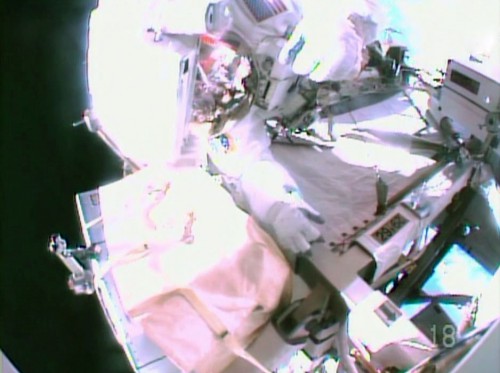
After closing the thermal cover of the Quest airlock, Wiseman and Wilmore pressed immediately into critical “buddy checks” of each other’s suits and safety tethers. They then separated and headed for their first work site. Wiseman—making his second career spacewalk, following last week’s EVA-27—assisted his first-time crewmate in moving along the Crew and Equipment Translation Aid (CETA) “spur.” Wilmore started out first along Face 1 of the S-1 starboard truss segment, which he reached by 8:35 a.m., dropping the Green Hook from his tether bundle to enable him to safely venture further outboard along the expansive truss structure.
Meanwhile, Wiseman climbed up to the Starboard CETA Cart and transferred his crew lock bag, containing his tools, onto an Articulating Portable Foot Restraint (APFR). He released the bag/APFR “bundle” and attached it to his Body Restraint Tether (BRT). The latter was first tested aboard the shuttle in the mid-1990s and is designed to hold a spacewalker steady, whilst clamped to a handrail, and carries the benefit of freeing the hands to perform useful work. Serving as a “third hand,” the BRT consists of a stack of balls, connected through the center by a cable, with a clamp on one end and a bayonet probe on the other, attaching to Wiseman’s suit. He was thus able to bend and twist the BRT to the appropriate position, then “lock” it in place with a knob which tightens the cable.
Carrying his tools, Wiseman joined Wilmore out on the S-1 truss, where he too dropped his Green Hook. The two men then headed farther outboard, past the S-3 Solar Alpha Rotary Joint (SARJ), until they reached the 3A solar array and the location of the failed SSU on the Beta Gimbal Platform, at the base of the Mast Canister Assembly on the S-4 truss element. Wilmore stowed the ORU bag containing the replacement SSU onto the nearby S-5 truss, whilst Wiseman installed the APFR and crew lock bag onto a Worksite Interface (WIF) socket. He removed his tools and installed them at the work site, then ingressed the APFR to take the lead role in the SSU changeout.
“Timing was a factor for the replacement of the Sequential Shunt Unit,” NASA explained in an overview of EVA-28. “The spacewalkers needed to remove the failed, suitcase-sized unit and install its replacement while the station passed through the Earth’s shadow and electricity was not being generated by the solar array.” Pausing to await eclipse, the replacement effort kicked off in earnest at 9:44 a.m. Notwithstanding some difficulty in breaking torque on the SSU bolts, and with a touch of added muscle, Wiseman released and pulled out the failed unit by 9:57 a.m. and stowed it. Monitoring the progress of the spacewalk from Mission Control in Houston, Texas, was a team headed by Flight Director David Korth—who fulfilled a similar role in charge of the troubled EVA-23 in July 2013—and seated at the Capcom console were veteran spacewalkers Ricky Arnold and Doug “Wheels” Wheelock. By 10:10 a.m., the replacement SSU was in place, and a few minutes later Mission Control’s Station Power, ARticulation, Thermal and ANalysis (SPARTAN) console reported a satisfactory power-up of the new unit. It ran smoothly through its early checks during the remainder of EVA-28, and the 3A power channel was expected to be brought back online today (Thursday, 16 October).
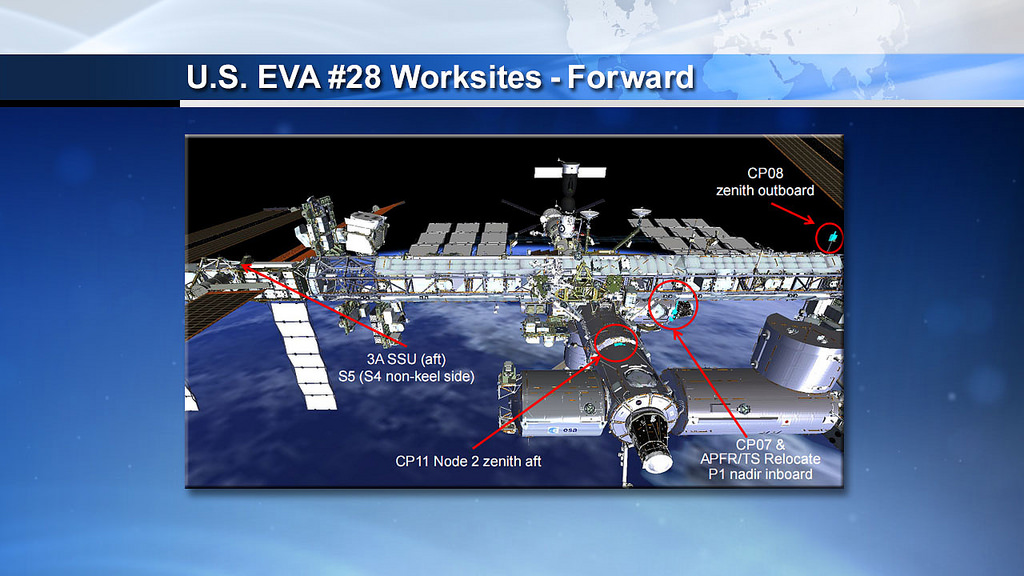
Following the completion of their first major task, Wiseman and Wilmore headed inboard along the truss, picking up their Green Hooks as they went along. Wilmore stowed the failed SSU at the Quest airlock and picked up a small ORU bag for his next task, after which the duo met at the Camera Port (CP)-7 site on the P-1 truss at 10:55 a.m. A few minutes later, Wiseman released the APFR tool stanchion and moved it further inboard to the central S-0 truss segment, which puts it out of the way in readiness for the Leonardo PMM relocation, which is anticipated to take place in July 2015.
Returning to CP-7, Wilmore unbolted and removed the failed camera group—which has suffered a broken zoom feature—and handed it to Wiseman. By 11:30 a.m., its electrical connectors had been removed and protective caps installed and the astronauts moved the CP-7 stanchion to its new location on the space-facing “end” of the Harmony node (known as “zenith-aft”), at the junction with the U.S. Destiny laboratory module, where the CP-11 camera group is situated. Wilmore installed the stanchion at CP-11 and mated the electrical connectors.
Meanwhile, Wiseman headed “port-zenith” to the CP-8 camera group, where he released a trio of bolts of the Wireless Video System External Transceiver Assembly (WETA), removed the unit and attached it to his BRT for transportation to its new home. Rejoining Wilmore at about 12:15 p.m., as the space station passed high over South America, the two men were astonished to witness a Bolivian volcano in the process of erupting. There was precious little time to admire the view, however, and as Wilmore toiled to install the WETA at CP-11, Wiseman translated back to the Quest airlock to stow the CP-7 camera group and collect a replacement unit in a large ORU bag.
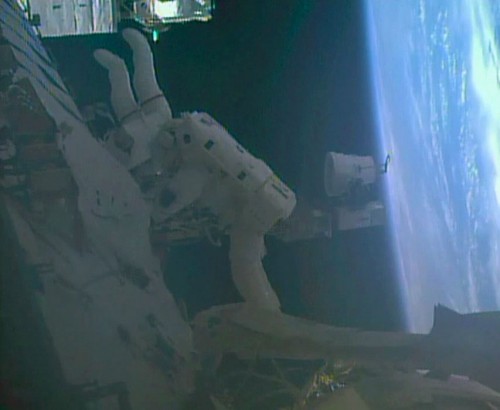
Wilmore completed his task of securing electrical connectors to provide power to the WETA by 1:20 p.m., as the ISS passed into a spectacular orbital sunrise, high above the Tasman Sea. A little after 2 p.m., a good signal was received from the newly relocated WETA. Elsewhere, Wiseman brought the replacement camera group and installed it at the CP-8 location, on the port-side truss, then paused to check the alignment of the lens cover and ensured that it was square.
In spite of some discussion of adding several “get-ahead” tasks to EVA-28, it was ultimately decided to “declare victory” for the day and the duo cleaned up their respective work sites and headed back to the airlock. The spacewalk ended at 2:50 p.m. EDT, after six hours and 34 minutes. With its conclusion, EVA-28 gives Wiseman a total of 12 hours and 47 minutes of EVA time in two excursions, placing him in 119th place in the list of the world’s most experienced spacewalkers. Putting this into context, in terms of EVA time, Wiseman is now slightly behind U.S. astronaut Al Drew and just ahead of Apollo 12 and Skylab astronaut Charles “Pete” Conrad. Having now executed his first EVA, Wilmore now sits at 163rd on the list, out of 210 total spacewalkers. This places him just behind U.S. astronaut Nicole Stott and slightly ahead of his Expedition 41 crewmate Aleksandr Samokutyayev.
Aside from the replacement of the failed SSU, EVA-28’s relocation of external cameras will prove critical for next year’s scheduled arrival of the first International Docking Adapters (IDAs) for the long-awaited Commercial Crew vehicles. According to Space Station Integration Operations Manager Kenny Todd, these EVAs mark the beginning of a salvo of spacewalks which will run into the spring and summer of 2015. Mr. Todd stressed that the two contingency EVAs last December and also a third unplanned spacewalk in April 2014 by Expedition 39’s Rick Mastracchio and Steve Swanson “had left some things out there that we knew we wanted put back in proper order.” He added that there was an urgent need to tend to power-related issues and improve the station’s fault-tolerant capability, ahead of several more complex EVAs next year.
Current plans call for two U.S. spacewalks in January 2015, two others in April and June and a further pair in August to route cables and utilities in support of the relocation of the Leonardo Permanent Multipurpose Module (PMM) and the Pressurized Mating Adapter (PMA)-3. This will lay the groundwork for the delivery of two International Docking Adapters (IDAs) in support of Boeing’s CST-100 and SpaceX’s Dragon V2 Commercial Crew vehicles. The Leonardo PMM will be robotically transferred in July 2015 from the nadir port of the Unity node to the forward port of the Tranquility node, whilst PMA-3 will be moved in the late August timeframe from its current berth on Tranquility to the zenith port of the Harmony node for Commercial Crew operations.
Want to keep up-to-date with all things space? Be sure to “Like” AmericaSpace on Facebook and follow us on Twitter: @AmericaSpace



